Article | February 1, 2024
Dynamic biomarkers to optimize bioprocessing: scale up cell line productivity
The successful production and manufacture of biopharmaceuticals depends on reliable bioprocessing. Used to create diverse bio-based drugs, from cell therapies to vaccines, antibodies, and protein therapeutics, bioprocessing aims to select and cultivate highly stable and productive cell lines from which the highest yield of cells can be harvested and formulated into a final product.
There are many factors that can enhance or inhibit growth of cell cultures used in bioprocessing, and optimizing conditions for cell quantity and quality becomes more complex as scale-up occurs. Transitioning from petri dish to large-scale bioreactors presents challenges to maintain consistent cell line performance, and monitoring process variables throughout production is critical to minimize batch-to-batch heterogeneity. As such, dynamic biomarkers can be powerful tools for analyzing, monitoring, and optimizing the bioprocessing workflow.
Growing & changing: Characterizing dynamics in cell culture systems
Dynamic biomarkers, inclusive of metabolites, lipids, and proteins, are indicators of metabolic changes occurring in living cells over time. They are produced endogenously in the cells, but can also be introduced into the biological system from exogenous sources such as nutrient and media exposures. By using mass spectrometry to assay these biomarkers in both cell lines and the media they are grown in, we can identify changes in the cell culture system caused by an array of influences over time – from modifications to the cultured environment itself to external factors such as bioreactor temperature.

This insight is critical for improving bioprocessing robustness and reproducibility across the production lifecycle. Many biopharmaceutical manufacturers see the value in dynamic biomarker discovery, but due to limited bioanalytical options for efficient mass spectrometry profiling at scale, have largely had to rely on targeted approaches to date. Targeted methods allow for monitoring only a handful of predefined biomarkers.
More biomarkers, greater yield: Amplifying process control with discovery mass spectrometry
The emergence of next-generation mass spectrometry has scaled the breadth and speed at which nontargeted discovery screenings can be performed, broadening the potential applications for dynamic biomarkers in bioprocessing. Sapient’s rapid liquid chromatography-mass spectrometry (rLC-MS) systems are capable of measuring >15,000 small molecules and thousands of proteins per biosample, including in cells and media, in less than a minute per sample. By capturing a broader range of omics data, we can identify the most biologically relevant signals and amplify the potential to discover novel biomarkers that inform on overall cellular metabolism, substrate utilization, and the effect of process adjustments on cell line productivity.
Some critical applications in which discovery mass spectrometry can add value include:
Cell Line Selection and Development
Nontargeted dynamic biomarker profiling enables biopharmaceutical manufacturers to assess and compare the metabolic profiles of different cell lines to identify high-performing candidates for bioproduction – for example, the cell line that produces higher levels of a metabolite that is favorable for the particular end product. These analyses can greatly improve the quality of cell line selection and efficiency of development up front, instead of relying on trial-and-error modifications.
Growth Media Formulation
Discovery mass spectrometry can be used not only to assay cells themselves, but also the media in which the cells are grown. Comparing biomarker profiles of media as different nutrients are added provides for a comprehensive understanding of the cell line’s nutritional needs and supplementation requirements. These markers could also denote accumulation of toxicants in the media that could jeopardize cell line quality. Collecting this information via interval profiling, media formulations can be adjusted and optimized over time to maximize cell line productivity and yield.
Batch-to-Batch Reproducibility
As processing scales up to produce larger cell cultures, minimizing batch-to-batch variation becomes essential. Maintaining stability over extended culture periods can be challenging, as physical, chemical, and biological factors can all be sources of variability. With discovery mass spectrometry, we can identify dynamic biomarkers associated with specific cellular states that can serve as early indicators of process deviations or performance issues. Periodic profiling of the cell culture can capture biomarker changes and enable timely intervention before batch quality is compromised.
It is clear that discovery mass spectrometry has a vital role to play in optimizing bioproduction processes. Metabolite, lipid, and protein biomarkers read out the dynamic changes occurring in the cell line and its media as growth progresses, providing valuable insight into how endogenous processes and external influences affect cell culture quality, stability, productivity, and yield.
Now, with technologies to enable efficient discovery screenings, biopharmaceutical manufacturers can take a nontargeted approach to identify the most biologically relevant dynamic biomarkers in their cell culture systems. This amplifies the ability to make informed bioprocessing decisions, ultimately maximizing yield and enhancing quality of the end bio-product.